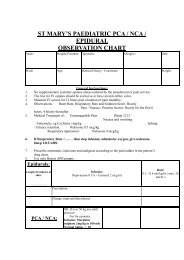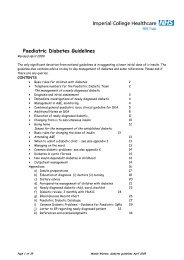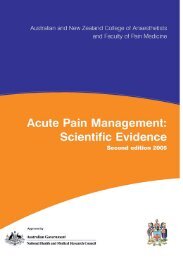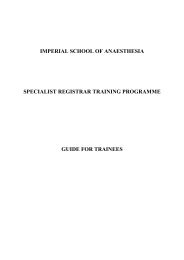TEG Interpretation - St-marys-anaesthesia.co.uk
TEG Interpretation - St-marys-anaesthesia.co.uk
TEG Interpretation - St-marys-anaesthesia.co.uk
Create successful ePaper yourself
Turn your PDF publications into a flip-book with our unique Google optimized e-Paper software.
BASIC GUIDE TO<br />
<strong>TEG</strong>® INTERPRETATION<br />
(t) 020 8371 9908
Cardiac Proto<strong>co</strong>l<br />
All samples are kaolin activated<br />
Sample When Cup Type Why Do It?<br />
No.<br />
1 On induction • Plain (clear) cup and pin Gives baseline haemostatic<br />
If heparin suspected use profile<br />
heparinase bonded (blue) cup<br />
and pin as part of a split sample<br />
2 Re-Warmed<br />
(approx<br />
• Heparinase bonded cup and<br />
pin (blue)<br />
Early identification of any<br />
<strong>co</strong>agulopathy that starts to<br />
36 O C) (2)<br />
develop during bypass<br />
3 10 mins post Split sample:<br />
1. Checks heparin reversal<br />
protamine • Plain (clear) cup and pin 2. Gives post bypass<br />
• Heparinase bonded cup and<br />
pin (blue)<br />
haemostatic profile –<br />
identifies cause of<br />
<strong>co</strong>agulopathy in bleeding<br />
patient (see suggested<br />
treatment proto<strong>co</strong>l)<br />
4 Post op ITU – Split sample:<br />
1. If it is indicated by a<br />
if indicated • Plain (clear) cup and pin<br />
developing <strong>co</strong>agulopahy<br />
• Heparinase bonded cup and<br />
pin (blue)<br />
profile seen in<br />
samples 1-3<br />
2. If patient is bleeding or<br />
‘going off’ clinically<br />
NB<br />
1. When using two cups ensure Plain cup is on the left of the heparinase cup<br />
2. This is the point the patient <strong>co</strong>mes off the pump/ end of last anastomosis in<br />
off pump case.<br />
(t) 020 8371 9908
Suggested Treatment Proto<strong>co</strong>l<br />
For kaolin activated samples<br />
<strong>TEG</strong>® Values Clinical Cause Suggested Treatment<br />
R between 11 – 14 min ↓↓ clotting factors<br />
X2 FFP or 8ml/kg<br />
(2)<br />
R greater than 14 min ↓↓↓ clotting factors X4 FFP or 16 ml/kg<br />
(2)<br />
MA between 42 – 47mm ↓ platelet function<br />
X 1 Platelet Pool<br />
G between 3.6 – 4.4 K (3)<br />
MA < 42 mm<br />
↓↓ platelet function X 2 Platelet Pools<br />
G less than 3.6K (3)<br />
LY30 at 7.5% or greater, Primary fibrinolysis Antifibrinolytic of choice<br />
with CI less than 1.0<br />
LY30 at 7.5% or greater, Se<strong>co</strong>ndary fibrinolysis Anti<strong>co</strong>agulant of choice<br />
with CI greater than 3.0<br />
R less than 3 min<br />
Prothrombotic state Anti<strong>co</strong>agulant of choice<br />
MA greater than 75mm<br />
G greater than 15K<br />
NB<br />
1. Blood product and antifibrinolytic treatment is only suggested if your patient<br />
is bleeding at a level you wish to treat<br />
2. These guidelines apply after you have ruled out heparin as a cause for the<br />
long R time<br />
3. A normal kaolin activated MA does not rule out platelet inhibitor effects. If<br />
the patient is/was on antiplatelet agents PlateletMapping results should be<br />
used to assess platelet function and hence need for treatment with platelets<br />
(t) 020 8371 9908
What Does <strong>TEG</strong>® Report?<br />
Clot strength<br />
(Platelet function)<br />
Clotting time<br />
(clotting<br />
factors)<br />
Clot<br />
kinetics<br />
Clot stability/<br />
Clot breakdown<br />
(t) 020 8371 9908
<strong>TEG</strong>® Parameter Definitions<br />
• R = Reaction time<br />
– The reaction time is the time from when the blood was placed in the<br />
<strong>TEG</strong>® analyser until the initial fibrin formation ie how long it takes for<br />
the blood to start to clot, and is therefore a measure of clotting<br />
factors<br />
• K = Kinetic time<br />
– The K time is a measure of the speed taken to reach a specific level of<br />
clot strength. Together with the alpha angle it is a measure of clot<br />
kinetics<br />
• Alpha Angle<br />
– Measures the speed of fibrin build-up and cross-linking (clot<br />
strengthening)<br />
• MA = Maximum Amplitude<br />
– The maximum amplitude represents the ultimate strength of the clot<br />
and is a measure of platelet function. It is a direct function of the<br />
maximum dynamic properties of fibrin and platelet bonding via<br />
GPIIb/IIIa.<br />
• LY30 = Lysis 30 minutes after MA<br />
– It shows any breakdown of the clot and therefore gives an idea of clot<br />
stability<br />
(t) 020 8371 9908
<strong>TEG</strong>®® Directed Therapy For Bleeding Patient<br />
Low MA<br />
Platelets indicated<br />
Prolonged R<br />
(not heparin)<br />
FFP<br />
indicated<br />
Clot<br />
kinetics<br />
High LY30<br />
antifibrinolytics<br />
indicated<br />
(t) 020 8371 9908
Qualitative Analysis<br />
Normal<br />
Coagulopathy/anti<strong>co</strong>agulants<br />
Long R time<br />
Reduced platelet function<br />
Low MA<br />
Primary fibrinolysis<br />
High LY30<br />
Hyper<strong>co</strong>agulable<br />
Short R time, High MA<br />
DIC<br />
<strong>St</strong>age 1 – hyper<strong>co</strong>agulable state with<br />
se<strong>co</strong>ndary fibrinolysis<br />
DIC<br />
<strong>St</strong>age 2 – hypo<strong>co</strong>agulable state<br />
(t) 020 8371 9908
PlateletMapping<br />
There is a kit for monitoring the effect of platelet inhibiting drugs such as aspirin and clopidogrel.<br />
AA (if looking at aspirin) or ADP (if looking at<br />
clopidogrel) – Represents fibrin & platelets<br />
unaffected by platelet inhibiting drugs ie<br />
platelets that are still functioning<br />
A (activated) – represents fibrin only clot ie no<br />
platelet aggregation<br />
K or KH – represents fibrin & thrombinactivated<br />
platelets ie maximum platelet<br />
aggregation<br />
The traces run for a maximum of 20 minutes. Overlaying the traces causes the software to calculate<br />
and display % inhibition and % function.<br />
(t) 020 8371 9908
What To Look For In An Etest<br />
• Numbers in min/max are changing<br />
• Final value 1800 – 2300<br />
• Message etest ok<br />
• If message is ‘not at equilibrium’ – retry<br />
• If message is ‘etest is off centre/out of range’ – can be<br />
tweaked with trimmer tool – report to Site<br />
Administrator<br />
(t) 020 8371 9908
MEDICELL LTD<br />
70-72 Ballards Lane (Rear)<br />
The Mews, Off Princes Avenue, London N3 2BU<br />
T: +44 (0)20 8371 9908<br />
F: +44 (0)20 8371 9906<br />
E: enquiries@medi-cell.<strong>co</strong>.<strong>uk</strong><br />
www.medi-cell.<strong>co</strong>.<strong>uk</strong><br />
ME59011.REV04 – Medicell Basic Guide to <strong>TEG</strong>® <strong>Interpretation</strong><br />
(t) 020 8371 9908










